Part 7 - Gibara to Rancho Luna, and Trouble with El Ministerio del Interior (Part 1)
We were only just beginning to figure out how to do some things in Cuba. The process of discovery and learning is what fuels the traveller, but some places on earth are so different that it can take years or never to begin to crack or comprehend the cultural enigmas. For your humble narrator, Cuba is a country that continually amazes, blending familiarity with strangeness in a way that always makes one want to explore a little more. It’s not for the beauty of the countryside, the coasts, rivers, nor the beaches, but for the culture, the people, and the way everything functions (or not) there.
Fisherman Buddy found us our driver who took us to the Holguin Bus Terminal for ten bucks. We had a couple of hours to kill in Holguin before our tourist bus (Viazul) arrived, and so I poked around the area of the station to find food, and maybe a car that could take us to Cienfuegos so we wouldn’t have to fraternize with tourists.
There wasn’t much going in the coche particular department, but one taxi quoted something over $200. Taxis! During our whole trip, we only took one taxi in Cuba, and that was from the airport, on arrival, when we hadn’t known better. I remember visiting Brooklyn last year and it was similar: you called a car, never a cab.
Anyway, the bus was right on time and very efficient. Apparently the Viazul company has that reputation. Certainly, nothing else in Cuba was ever very punctual. This one had probably already come all the way from Santiago.
The fare was $25 each, but we had to pay a bit extra for our Pro Packs, which had put us overweight. Between the two of us it seemed a lot of money in Cuba, but after all it was a nine hour journey to Santa Clara. Theoretically it could also have been very comfortable, since there were not a lot of people on the bus, but as it was the seats they had installed seemed to want to eject their occupants, which is to say, us. Anyway, for a while there was an unidentifed but engaging American action movie, in the heist genre, to entertain us. As an avid video-viewer, it was comforting to watch a screen again. The movie was hardly spoiled by the sorry sound which made speech unintelligible, and the poor picture which made image details indiscernable and the Spanish subtitles unreadable.
I also managed to while away at least an hour and a half doing my Pimsleur method "Essential Spanish" lessons, at least twenty-five hours of which I’d loaded onto my mp3 player. I sat there, staring out the window, muttering phrases back at my two patient, agreeable latin friends. Sure, they were deaf, and pre-recorded, but I can say that for anyone trying to learn Spanish (or any other language) I heartily recommend Dr. Pimsleur’s clever and effective method, and Simon and Schuster have it in audiobook form for quite a few languages.
All the way to Santa Clara, and we only had one 30 minute breakdown! It was a very successful trip and I was very impressed with Viazul. But, in the end, it had been too sterile, and we never took another tourist bus again.
Admittedly, it ended up working to our benefit. We arrived in Santa Clara at 10 pm, not even dimly aware that the bus terminal was as far out from the centre of the city as it was. We had no where to stay and no leads, but it turned out that a pair of middle-aged Belgians that we’d met on the bus had made arrangements, and their hosts were waiting for them at the terminal, and it turned out there was an extra room! So, we all piled into a carriage and were drawn into town equestrianally ($5).
To another abundantly hospitable casa. On arrival, the hostess made me and Jay a hardy and nourishing meal even though it was nearly midnight. The next morning, she spent at least an hour on the phone trying to get us either or both of a car to Cienfuegos and a casa once there.
We only really cared about the car, but by the time we’d figured out that it wasn’t going to happen through her, we’d missed both the daily buses: we’d naïvely assumed that because of the proximity and supposed popularity of Cienfuegos it would be commutable throughout the day.
So, we hoisted our boats onto our backs, bade our hosts farewell, and headed the two blocks to the town centre to try and find someone with a car. We didn’t see any other alternative.
Now, in hindsight, I see that perhaps we would have fared better by somehow making our way to the outskirts of town, along the road that went towards Cienfuegos, and hitchhiked from there. Or else we could’ve gone back to the bus station and loitered, since it turns out that often that is the most common place for cars to troll for passengers.
The "rules" for hiring private cars change drastically depending on the danger to the driver of getting the famous 1500 peso fine (that’s pesos cubanos, of course, so around $60). In Santa Clara, it soon became evident that that danger was great: there were people with cars all around the centre area, but for the longest time not a single one would bite. It wasn’t even as if they would offer a high price: simply no one wanted to do it. The tourist taxis wanted fifty or sixty bucks. Ha! It’s only a 67 kilometre drive!
While we took turns trying to find a ride, the other would wait with the bags in the immense plaze in the centre of town, watching stuff happen. And in this way, in turns, we became enamoured with Santa Clara. Here was an inland city in Cuba that seemed to have virtually no tourists, lots of young people, and a happening vibrance.
Eventually I found a man who was considering giving us our ride. He was an older guy, and a pained and worried look overcame his face as he made his decision. His buddies all seemed to be saying it was his funeral, but that if was going to do it, take this or that route and be careful, and so on. He wouldn’t go lower than thirty, but by that point we were realizing that it was him or nothing until the next bus the next day.
So, this guy, like the guy who was the driver for our first private car ride (Bayamo to Antilla), figured a good starting strategy for not getting stopped by the cops was to have his wife ride shotgun. As we drove through town, his stress was palpable. Every turn of a corner was made slowly, and with neck craned to see what may lay ahead.
But as soon as we left the city limits, there seemed to be much less to worry about. There would probably be no police checks along that highway. We agreed that, if stopped, we’d been hitchhiking and they’d picked us up. Once again, if we could convince the police that no money had changed hands, there was no crime. Once again, it didn’t seem too plausible to me: why would they pick up hitchhikers and take that risk unless money was changing hands? Anyway, I didn’t argue.
It turned out to be the best ride of our trip. Not only had this couple been in the Revolution, but they’d fought in Che’s batallion. And check this: they’d met each other while holed up in the Sierra Maestre, had fallen in love, and had sworn to marry each other if and when the Revolution was won. The historians amongst you will remember that that is exactly what happened.
This guy had gone on to fight with the Cuban army for his entire life, travelling all over the world on service. They both had a tremendous belief and lifelong dedication to the Revolution, and to Che. I found it pleasingly ironic watching patriots perform police evasions, and I believe that the paradox is understandable given the downtrodden state of life in Cuba. Impossible to hold it against this wonderful and passionate couple, to be sure!
Cuba seems to have an immense black market trade in all commodities, from rice to gasoline. Hence all the police everywhere, stopping cars regularly. This is why it isn’t always easy to get a private car, and why the Cubans we tried to help help us were not safe from being fined until they got us out of the car unseen. I’m profoundly glad that no one ever got nailed on our account, at least so far as we know.
At one point, the woman asked us if we’d gone to visit Che’s mausoleum, one of the things Santa Clara is famous for. We flusteredly tried to explain that we’d only been passing through and really we just wanted to paddle our boats somewhere, and... but it was too late for all that. The couple sort of glanced at each other and then stared off at the road ahead, silent and stone faced. Clearly this was a major offense.
We recovered by saying that we were surely coming back through, and would just love it if they would join us in a trip to all the city’s mausoleums and monuments, or at least for coffee. At this, they reanimated and with much enthusiasm they said they had friends with a great casa close to where they lived, and here was their phone number, and when we came back through we’d all get together and have coffee and see the monuments. Great! Just imagine checking out their old photos and army equipment and stuff...
And so by the time we got to Cienfuegos, whereas at first they’d wanted to deliver us as shallowly into town as possible and get the hell out, now we were all good friends and they helped us check out a couple of different casas. They wanted very much to make sure that we found something to our satisfaction. We parted with big hugs, and kisses on the cheeks.
On the way up the street we’d been driving we saw a guy standing outside a door in silk leopard-print boxers and a shirt. He was potbellied, mustached, and carried a drink in his hand. A few minutes later, after seeing another place and finding it full, we were directed back to a certain address, and sure enough it was the casa belonging to leopard skin boxers guy. His name is Sissi (!) and his wife’s name is Marta, and they have a stylin’ and swingin’ pad in Cienfuegos, telefono 207991. When you get there, check out the photograph, near the bar area of the living room, of him with his shirt off, donning a big sombrero, and doing air guitar with a beer in his hand. Turned out he’s a doctor, too.
It was $35 total for both of us to stay there, including dinner and breakfast.
We checked out Cienfuegos but we don’t have much to report. It’s got one intensely prettified and touristed street, and a malecon area where reputedly there’s a night life. There are some beautiful colonial buildings, blah, blah, blah. Mostly we wanted to find out whence we would launch in the morning.
Cienfuegos has that one long finger-like peninsula, where the malecon is, and we picked a spot down that way where it seemed we would’t attract much attention, and where there was a nice grassy area next to a miniscule beach offering a sheltered and easy entry to the bay.
And so the next morning there we were, trying to pack our boats with all of our belongings for the very first time. There had been talk of attempting to do a test pack in Toronto before leaving, but it had never happened. Especially doubtful was just how Jay’s guitar would fit. It’s a mini-guitar, well suited for backpacking, but the Cooper kayak is skinny and all the longerons make it even trickier to pack.
With the Cooper, the frame is completely assembled before pulling the skin over it. So, Jay got his guitar in his Pro Pack dry bag and fit that into his frame before inserting the frame into the skin. That seemed to work well, but we had misgivings about how well this method would work on a day to day basis: we hoped to be able to just leave them assembled for at least a few days while we made our way down the coast. It’s neat the way you can assemble and disassemble a folding kayak, but between drying and going through the procedure twice a day, it can get old.
There turned out to be a whole stroke of swimmers there, as well as some other fishermen types, and so we ended up with a bit of an audience gawking at our assembly procedure. They commented amongst themselves quite heavily, but didn’t bug us until finally one of us said something in Spanish, at which point the questions and advice began to flow.
When I told the fishermen about our plan to kayak all the way to the Trinidad area, they (like others before them) thought we were crazy. They said it was "open sea" and that while we’d be fine to Rancho Luna, beyond there it would be lunacy. I didn’t tell Jay, but I stored the information. I wasn’t sure whether to believe them, since they hadn’t really displayed any knowledge of or experience with sea kayaks. And anyway, weren’t we on the lee side of Cuba? And wasn’t there supposed to be a protecting coral reef all along that way?
It didn’t matter. One problem at a time. We were tired of being told we couldn’t do things! It was entertaining for a while, sure... but morale was going to be seriously affected if we didn’t soon spend some contiguous quality time on the water. Immediately upon being packed, we set off.
The wind was already high, and we had to paddle harder than ever: our boats were fully loaded and the bay was poorly sheltered. Also, before long we realized we didn’t know which way to paddle. Looking at the horizon, we could not make out where the mouth of the bay would be. The road atlas was little help, since we couldn’t match up what we could see with what was indicated, and anyway we’d lost much faith in the accuracy of that map ever since we’d found that large lake missing from it along the Rio Cauto.
We must have gone at about right angles to the direction we should have gone, and ended up moving east and then southeast, staying parallel to the shore. South, in a straight line, would have got us directly to the mouth, and within six or seven kilometres. Next time, maybe I’ll bring a compass. Nautical charts wouldn’t hurt either, but that requires actually knowing where one is going.
We were having a hell of a time getting our boats to go straight, and to top it off Jay was concerned that there was a leak in his boat because water was accumulating below his soggy seat. We hoped it was just the water splashing into the cockpits from the waves – as usual we hadn’t put our sprayskirts on and were too busy to rectify.
The shore and scenery were unremarkable, and after an exhausting battle we ended up over in the south-east part of the bay. We decided to head what we hoped was west, around the south side of an island we could see, one that we thought we’d identified on our map, and that maybe there we could rest our arms a little without constant relocation by the wind.
We hadn’t hoped for much from that island: it appeared entirely overrun by mangroves, but when we rounded it we found an old abandoned port and a small sheltered beach. Even more interesting, the port was populated by half-sunk and rusting hulks. We stopped to rest, eat, and bask in our success. We were in no huge rush, since through Sissi and Marta we’d already booked a casa in Rancho Luna where someone was supposed to be awaiting us. We would not have to run around looking for accomodation that day, and so there was no particular need to get there much before sunset.

| 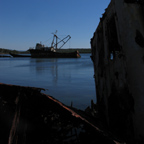
|
We reckoned that we were very probably on Cayo Ocampo, and that it would be difficult for us to miss the mouth if we just set out west parallel to the shore. We picked a point and tried to bee-line it there, but damned if we didn’t miss having rudders on our boats! There was a repulsive amount of pull to the right, and I had to point my bow all the way towards the south if I wanted to eventually form a nice big arc where I ended up pointing west-ish. Inefficient, but far better to paddle with both arms at full force than constantly compensating using only one.
It was a great battle, but we ached for some shelter so we could rest, at least to sit peacefully in the water if we couldn’t land. We finally came round the point marking the beginning of the mouth’s channel. In there, the wind was right at our backs. This may sound good, and it’s better than the reverse, but it doesn’t mean less work. You still have to paddle your arse off to stay in control.
Ahead we couldn’t help but spot the Hotel Pascaballo, which had an inviting wharf complete with bar. We swung by there to investigate it as a break spot, but the water was too rough to leave our boats merely tied up, and the wharf’s deck was too high up for us to get them out of the water. A little exasperated and even more exhausted, we set back out. Surely by leaving the bay we’d finally be shielded from the wind’s attack.
And as we broke out from the mouth we could see, off to the left, to the east, the smooth surface of easy paddlin’ waters. The Caribbean at last!
Just then a large boat, a passenger ferry by the looks of it, appeared off to our starboard side. There were a half dozen men along its railing calling out and waving their arms. I gave them a jovial salutation and made to head off into the sun.
But they were adamantly yelling at us. We feared the worst and briefly discussed whether we should just ignore them. We decided, wisely I think, to paddle over and see what they wanted.
Well, they wanted nothing short of our absolute downfall! There they were, a few of them in military uniform, all chorusing that we were not to paddle any further, and that we had to turn around and return to the bay.
I tried to explain that it was impossible, the wind was far too strong for us to return to the bay, and that lo! Over there where we were going the water was a calm as nirvana!
No, no, that wasn’t the way it was going to be for we intrepids. The looks on their faces did not speak of friendly concern: we were contravening their system and everything their authority stood for. The ferry was not on its way somewhere, either: it was specifically after little old us. We did not have permission to leave the bay and if we couldn’t return the way we’d come, we had to land at that hotel’s pier.
Well, we tried to explain that we couldn’t land there because it was too high, but this didn’t seem to sway them out of their resolve to quash our haphazard plans.
With heavy hearts we turned around and forced our way into the wind and back to that wharf. Once again, we couldn’t really work out a good way to get our boats out of the water there, and the shore itself was lined with brutally jagged rocks. It would not have been a huge problem if there hadn’t been so much angry chop, but, well, there was so much angry chop!
A bit further up the bay’s gullet, on the same side as the hotel, was a rickety old dock, quite low, which if it would hold our weight would be suitable for removing ourselves from the water. We spotted the fisherman who belonged to it and requested his okay for us to disembark there. He didn’t seem to mind or care, waved us in, and then promptly disappeared into his hovel.
We hauled ourselves out of our cockpits and onto the dock. We had to use our dangling feet to secure the kayaks from getting blown off to sea, and, when they swayed the other way, to keep them from getting impaled by the numerous rusty iron rods that projected from under the dock. We sat there thus, catching our breath and trying to think how best to withdraw our boats from the water.
Meanwhile, the ferry, which had retreated after we’d reversed direction, had changed its mind about leaving us alone and was heading straight for us again. I still don’t fully understand why. Jay thought it might be because we’d pulled up to an ordinary citizen’s property and they didn’t go for that: they’d wanted us to go to the hotel’s wharf.
In any case, clearly they’d thought better about leaving us to our own devices, because there they were pulling right up to the rocks not thirty feet away from us. Five or six men jumped to shore and marched over to where we sat rolling our eyes.
They wanted to take us and our ‘yaks onto their boat, although it was unclear why. We thought that maybe they wanted to take us to the hotel’s dock. O silly Canadian optimists!
We protested about them manhandling our unusual sea vessels. I had a fear of bending the longerons out of shape if the boats were lifted by the ends while they were fully weighted down by our belongings. I still don’t know how well the Coopers handle this, although it is now certain that some of the cross-bar connections pop out when the boats are portaged with gear inside. In fact, some of these connections can pop out while paddling in medium waves. To be fair, though, I’ve heard that folding kayaks are designed to have a certain degree of redundancy, so that seaworthiness isn’t impaired by one or two failures. We both agree that this problem would likely be solved by using more of the velcro ties that Folbot already supplies with the Cooper for securing many of those connections.
The men trying to get our boats out of the water were surprisingly cool about our prissy resistance to their desires. I was saying I wanted to unpack some of the heavier stuff first, and whining about how they had to be careful and so on. In the end it was far too much trouble, and too unnerving, to explain, try to unpack the boat while it was still in the water, and make them wait, so we just lifted them out as was. We did our best to help support the boat from the middle and make sure they didn’t drag the hull or put them down on anything sharp.
Well, the ferry didn’t go to the hotel’s wharf. We headed straight across the mouth of the bay to a big cement structure on the other side. We’d noticed it before but hadn’t really thought too much about it, other than being warmed by the huge letters written across it reading Bienvenidos a la Cuba Socialista.
Now we know quite well that it was la Frontera outpost where el Ministerio del Interior monitors the comings and goings of all crafts. They have huge military searchlights and large, clunky, mounted binoculars. There were numerous armed soldiers populating the place. All in all, it didn’t seem like too congenial a situation.
Our kayaks were carried onto the Frontera’s quay, most of the men disembarked, and their boat left. Actually, we soon discovered that that base didn’t have their own boat, and that the ferry was really just what it looked like: it was the passenger ferry that plied the mouth of the bay. They’d commandeered it to apprehend us! What an honour!
Then the officer in charge showed up. He looked us up and down, glanced at our boats, demanded our passports, and left. At this point our level of nervousness increased ever so noticeably. No traveller likes to be separated from their passport, least of all when they might be in some degree of trouble.
We stood around speculating as to what degree it might be, but before long the officer returned, passports in hand. He was smiling, and for a glowing moment we figured that in a few minutes we’d be back in the water and paddling off, victorious.
No, though, he was smiling because he was a good-natured dude. But he had no good-natured news for us. It was more along the lines of: okay, you guys aren’t wanted by the law, and your visas are in order, but you’re walking from here, not paddling, so fold up and pack off.
We’d suspected as much, and had already begun to unload, and so again began the tear-down. While busying ourselves with this, we gently questioned the officer about what we could or could not do in Cuba. This is always a dangerous line: we only wanted to hear about what we could do. To hear that we could not do something would mean we could no longer truthfully claim ignorance about that thing.
He thought that rivers and bays were no problem and that we should be able to paddle to our hearts’ content in those... But then, I thought, of course that would be the perspective of someone working the country’s borders. Rivers and bays were someone else’s problem. I cynically feared that good folk like him just like to tell positive news when they think they can get away with it. In any case, up to that point on our trip, in rivers and bays it seemed as if he was right. Or at least that whoever’s problem it was wasn’t concerning themselves much with it.
We were very curious to know just how one goes about getting authorization to paddle outside the bay. We’d heard that foreign sailboats and yachts can do it, so why not us?
Well, he seemed to think it was the easiest thing in the world! You just go to the local marina international and request permission. He said they’d surely grant it, and then you just have to re-apply at every new port you get to. They just want to be aware of who is coming and going. They then notify any Frontera lookouts who will then happily let us go our way.
That sounded easy, but dubiously. But he was so keen on it that we slowed down our disassembly and asked him, since he was being so friendly and positive, if he wouldn’t mind contacting the marina international in Cienfuegos on our behalf. After all, he was a man of authority. Plus, he’d seen us, our passports, and our boats. He was in a perfect position to help us out.
He thought that sounded reasonable, and he went off to try it. We were so hopeful we stopped our packing. We stood there looking out at the Caribbean wistfully. Since we weren’t going to get in any serious trouble like being fined, jailed, or having our boats impounded, we were really starting to appreciate the travel aesthetic of being picked up by the Ministry of the Interior in a commandeered ferry. It was far more interesting than having glided uneventfully out of the bay, which is probably what would have happened in most other countries.
Alas, he returned shaking his head, shrugging, with arms extended in the universal gesture of helplessness. The Captain of the Port in Cienfuegos had said that we had to go to his office in person.
We finished packing and walked out of the gates of the Frontera base. We had to run to catch the very same passenger ferry that was now being used for its mundane purpose. Then, as a further insult, we had to pay to use it! This we did good-humouredly, but when the ferry flunky pointed at our kayak bags and then at the obscure listing for refrigerators in the posted fares, we had to draw the line. Forget it, buddy.
We found ourselves on the other side of the mouth of the bay, yet again, and walking up the embankment to where there was supposed to be a local bus to Rancho Luna and to Cienfuegos. Should we go back to Cienfuegos, find a place to stay, and apply to the Captain of the Port in the morning? Hell no! We arrived in Rancho Luna as the sun was setting.
It’s a small place, and finding la Casa Teresita was as easy as asking the second person we saw. She was waiting for us, and it wasn’t long before she was cooking up a tasty storm. She was an outstanding chef! My mouth waters thinking about her yuca garnished with fried garlic.
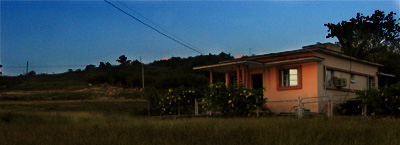
We had to rethink things. We were now a little more informed, and we realized that it behooved us to obtain permission before proceeding along the coast.
But really we were only a little less ignorant. It would turn out that there was no marina international in Rancho Luna. We also couldn’t know that although we'd resolved not to retrace our steps and return to Cienfuegos, we hadn’t finished with our dealings with the Captain of the Port in Cienfuegos. He who would later learn to curse our very existences...
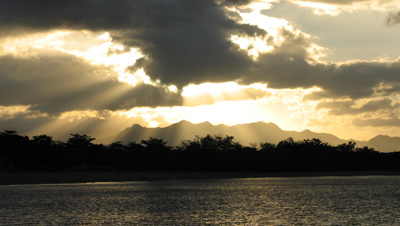
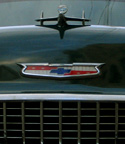

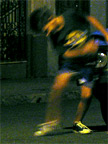
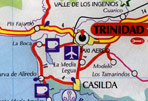
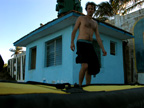


1 Comments:
You certainly know how to end a chapter and leave the reader aching for the next one. A great yarn!
Post a Comment
<< Home